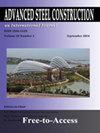Effects of strain regimes on the behaviour of headed stud shear connectors for composite steel-concrete beams
IF 1.7
3区 工程技术
Q3 CONSTRUCTION & BUILDING TECHNOLOGY
引用次数: 14
Abstract
In composite steel-concrete beam construction, one of the most common methods to evaluate shear connector strength and behaviour is through a push test. Push tests have been used as early as the 1960’s to predict the strength and behaviour of shear studs in solid slabs. The performance of steel-concrete composite structures is greatly dependent on the load-slip characteristics of shear connectors. Significant research work has been performed on composite beams with regard to their stiffness and ductility of the shear connectors for both solid and profiled slabs. This paper describes the strength and ductility of shear connectors in composite beams with both solid and profiled steel sheeting slabs when different strain regimes are imposed on the concrete element. An accurate non-linear finite element model using ABAQUS is developed herein to study the behaviour of shear connectors for both solid and profiled steel sheeting slabs. The reason for employing different strain regimes in composite steel-concrete beams is to properly simulate the behaviour of shear connectors in composite beams where trapezoidal slabs are used. The pertinent results obtained from the finite element analysis were verified against independent experimental results and existing design standards. Based on the finite element analysis and the experimental results, it is evident that the strength and the load-slip behaviour of composite steel-concrete beams are greatly influenced by the strain regimes existent in the concrete element.应变状态对钢-混凝土组合梁头螺柱剪力连接件性能的影响
在钢-混凝土组合梁结构中,最常用的评估抗剪连接件强度和性能的方法之一是通过推力试验。早在20世纪60年代,推力试验就被用于预测实心板中剪力钉的强度和行为。钢-混凝土组合结构的性能在很大程度上取决于剪力连接件的荷载-滑移特性。在实心板和异形板的剪力连接件的刚度和延性方面,对组合梁进行了大量的研究工作。本文描述了当混凝土单元受到不同应变时,实心钢板和异形钢板组合梁中剪力连接件的强度和延性。本文利用ABAQUS建立了一个精确的非线性有限元模型,研究了实心和异形钢板的剪切连接件的性能。在钢-混凝土组合梁中采用不同应变制度的原因是为了适当地模拟使用梯形板的组合梁中剪切连接件的行为。有限元分析得到的相关结果与独立实验结果和现有设计标准进行了验证。基于有限元分析和试验结果表明,钢-混凝土组合梁的强度和荷载-滑移性能受到混凝土单元中存在的应变状态的很大影响。
本文章由计算机程序翻译,如有差异,请以英文原文为准。
求助全文
约1分钟内获得全文
求助全文
来源期刊

Advanced Steel Construction
CONSTRUCTION & BUILDING TECHNOLOGY-ENGINEERING, CIVIL
CiteScore
2.60
自引率
29.40%
发文量
0
审稿时长
6 months
期刊介绍:
The International Journal of Advanced Steel Construction provides a platform for the publication and rapid dissemination of original and up-to-date research and technological developments in steel construction, design and analysis. Scope of research papers published in this journal includes but is not limited to theoretical and experimental research on elements, assemblages, systems, material, design philosophy and codification, standards, fabrication, projects of innovative nature and computer techniques. The journal is specifically tailored to channel the exchange of technological know-how between researchers and practitioners. Contributions from all aspects related to the recent developments of advanced steel construction are welcome.
 求助内容:
求助内容: 应助结果提醒方式:
应助结果提醒方式:


